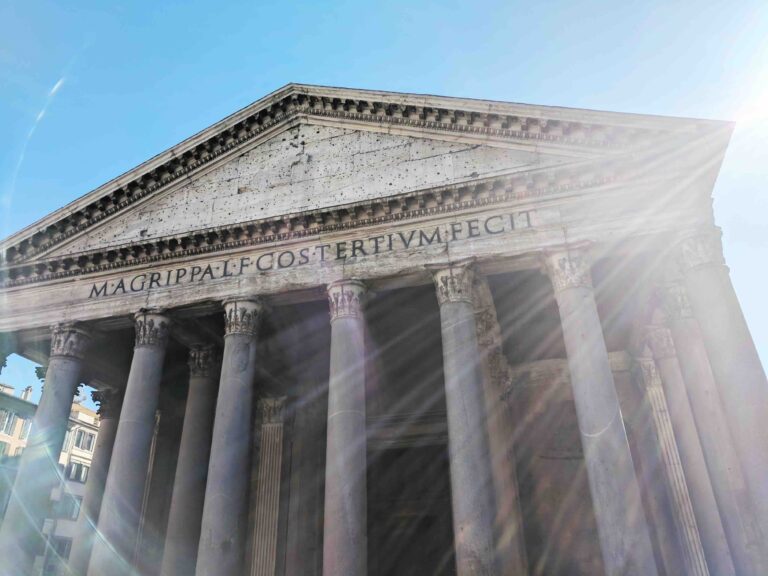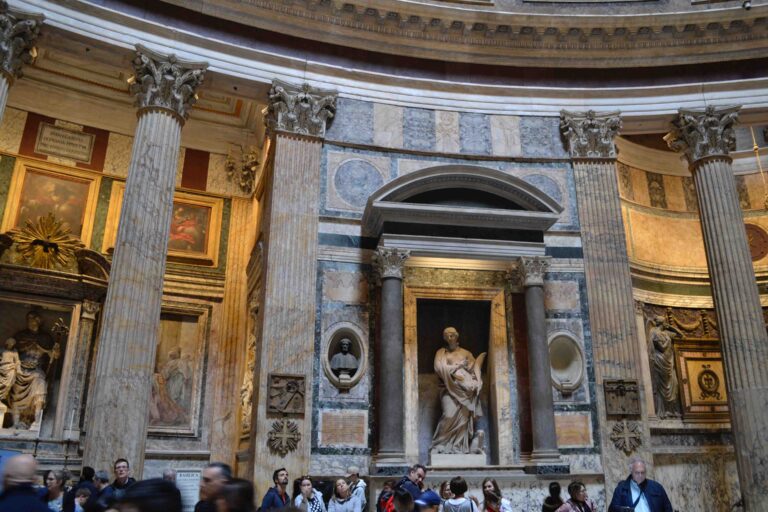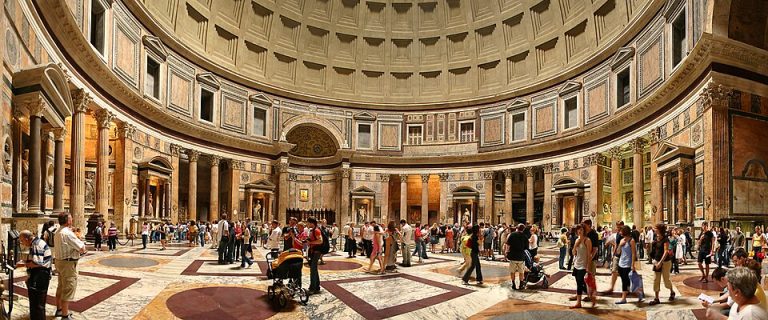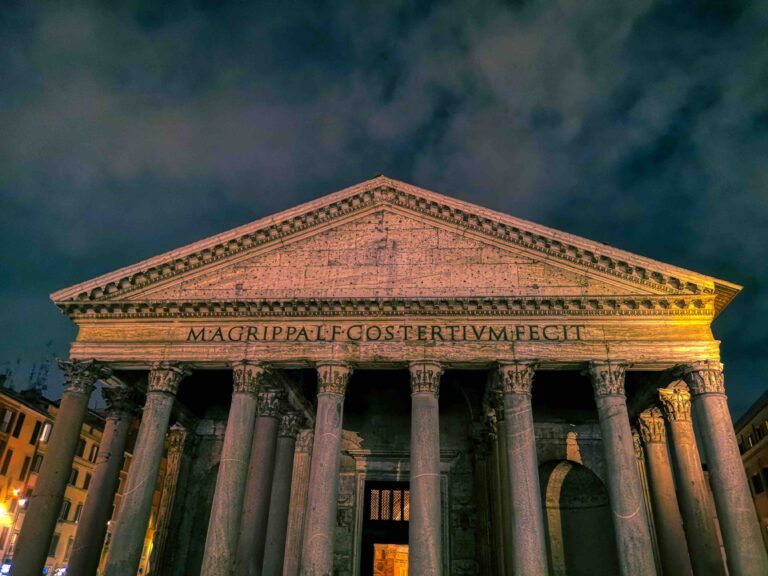Stand in the center of the Pantheon and look up. That’s when it hits you.
Above your head floats a massive concrete dome that has no business still standing after nearly two thousand years. No steel beams. No reinforcement. Just ancient Roman concrete, genius engineering, and a gaping hole in the middle that opens straight to the sky.
The Pantheon Rome ceiling isn’t just another pretty dome. It’s the largest unreinforced concrete dome ever built, and modern engineers still scratch their heads wondering how the Romans pulled it off. While other ancient structures crumble and need constant repairs, this ceiling has been holding strong since around 126 AD.
Walk into this ancient temple turned church, and you’ll find yourself in a space that feels both impossibly grand and strangely intimate. Light pours through that famous opening at the top, moving across the coffered ceiling like a sundial. When it rains, water falls right through the oculus and onto the marble floor below. It’s dramatic, it’s unexpected, and it’s absolutely mesmerizing.
Whether you’re an architecture buff, a history lover, or just someone planning a trip to Rome, understanding what makes this ceiling special will completely change how you experience the Pantheon. This guide will walk you through everything from the engineering secrets behind the dome to what you’ll actually see when you visit.
Let’s start with why this ceiling has captivated visitors for almost two millennia.
Quick Facts About the Pantheon Ceiling
Before we get into the fascinating details, here are the basics you need to know about the Pantheon dome.
The ceiling stretches 43.3 meters across. That’s about 142 feet, or roughly the height of a 14-story building laid on its side. Picture the dome of a major sports stadium, and you’re getting close.
What makes this really special is that the Pantheon ceiling forms a perfect hemisphere. If you could somehow flip the dome upside down and set it on the floor, it would create a perfect sphere that fits exactly inside the building. The ancient Romans were apparently very into their geometry.
Emperor Hadrian commissioned the building around 126 AD, though there’s some debate about whether he might have designed parts of it himself. Hadrian was known for his love of architecture, and the Pantheon was his passion project.
The dome weighs approximately 4,535 tons. Yet it sits there without any visible supports beyond the rotunda walls. No flying buttresses like you see in Gothic cathedrals. No hidden steel framework. Just walls and dome, working together through pure physics.
Here’s something else remarkable: the Pantheon is still in active use as a church called Santa Maria ad Martyres. It’s also remarkably intact compared to other Roman buildings. Walk into the Colosseum and you’ll see a ruin. Walk into the Pantheon and you’ll see something that looks pretty much like it did when Hadrian’s architects finished it.
The building earned UNESCO World Heritage status, and it remains the best-preserved Roman building in existence. That ceiling you’ll be staring at is mostly original, which is frankly astonishing.
The Architecture and Engineering Behind the Dome
Let’s talk about how the Romans built something that still impresses modern architects and engineers.
The Pantheon dome looks uniform when you first glance at it, but it’s actually an incredibly clever piece of engineering trickery. The Romans varied the thickness and materials throughout the structure to make it work.
At the base, where the dome meets the walls, the concrete is nearly 6 meters thick and made with the heaviest materials. As you move up toward the top, the concrete gets progressively thinner and lighter. By the time you reach the oculus at the crown, the dome is only about 1.2 meters thick.
This wasn’t just about saving materials. The Romans understood that a dome wants to collapse inward and downward under its own weight. By making it lighter as it goes up, they reduced the stress on the entire structure.
The coffered ceiling you see isn’t just decorative either. Those recessed square panels serve a structural purpose. Each coffer reduces the weight of the dome while maintaining its strength. Think of them like the holes in Swiss cheese. The cheese is lighter but still holds together. The coffers follow this same principle.
Now let’s talk about the concrete itself, because Roman concrete was different from what we use today.
The Romans called it opus caementicium, and they mixed it differently depending on where they were using it in the dome. At the bottom, they used heavy aggregates like travertine and tufa. These are dense stones that could handle the compression forces at the base.
As they built upward, they switched to lighter volcanic rocks. At the very top, near the oculus, they used pumice, which is so light it can float in water. This dramatic reduction in weight made the impossible possible.
Modern scientists have studied cores taken from the Pantheon concrete and found something interesting. The mixture contains volcanic ash from the region around Naples. This ash, called pozzolana, creates a chemical reaction with lime that makes the concrete incredibly durable. In fact, Roman concrete actually gets stronger over time as it continues to react with moisture in the air.
The dome also relies on an invisible force: compression. A dome naturally wants to push outward at its base. The Pantheon’s thick walls, which are about 6 meters deep, counteract this outward thrust. Embedded in those walls are relieving arches that you can’t see from inside, which help distribute the weight.
The oculus plays a crucial structural role too. That opening at the top eliminates weight at the most critical point where the dome would be under maximum stress. It also prevents the apex from becoming a weak point that might crack under pressure changes.
Engineers today use computer modeling to analyze the Pantheon, and they consistently find that the Romans got everything right. The stress distribution, the material choices, the thickness variations – it all works together perfectly.
Some modern concrete domes have tried to match the Pantheon’s span without reinforcement. They’ve all failed or needed additional support. Whatever the Romans knew about building this dome, they executed it flawlessly.
The Oculus: The Opening at the Top
The most dramatic feature of the Pantheon ceiling is undoubtedly the oculus. This circular opening measures 8.2 meters across, or about 27 feet. It’s the only source of natural light in the entire building.
Standing under the oculus creates an almost spiritual experience. You’re inside this massive, enclosed space, yet you can see clouds drifting past and birds flying overhead. The connection to the outside world feels deliberate and meaningful.
The oculus served multiple purposes for the Romans. Practically speaking, it provided light and ventilation in an era before electricity or mechanical air systems. The opening allows air to circulate, which helps regulate temperature and humidity inside the building.
Symbolically, the oculus represented a connection to the divine. The original Pantheon was a temple dedicated to all the gods, and that opening to the sky literally linked the earthly space below with the heavens above.
Now, everyone asks the same question: what happens when it rains?
Yes, rain falls directly through the oculus and into the Pantheon. It’s not a design flaw. The Romans planned for this. If you look carefully at the floor beneath the oculus, you’ll notice it’s slightly convex, meaning it curves upward in the middle. This gentle slope directs rainwater toward 22 small drainage holes set into the marble floor.
The drainage system works so well that even during heavy rainstorms, you won’t see water pooling inside. The rain falls, the floor sheds it to the sides, and it disappears into drains that lead to Rome’s ancient sewer system.
Watching rain fall through the oculus is actually magical. The column of water creates a curtain effect, and the sound echoes through the space. If you’re lucky enough to visit during a light rain, don’t rush for cover. Stay and watch. It’s one of those moments you’ll remember forever.
The light coming through the oculus changes throughout the day, creating different moods inside the Pantheon. Early morning light comes in at a sharp angle, creating dramatic shadows from the coffers. Midday light, especially in summer, creates a bright column that illuminates the floor directly below.
Photographers love the oculus because it provides natural lighting that changes constantly. The moving beam of light acts like a sundial, marking the passage of time across the ancient marble.
On April 21st, which is traditionally celebrated as Rome’s birthday, the light from the oculus hits the doorway at exactly noon. Some historians believe this timing was intentional, though whether the Romans actually designed it this way remains debated.
The oculus also creates interesting acoustic effects. Sounds seem to gather and swirl around the opening before dispersing through the space. Whisper something under the oculus and it carries farther than you’d expect.
The Coffered Ceiling Design
Look up at the Pantheon ceiling and you’ll see 140 coffers arranged in five concentric rings. These square recessed panels decrease in size as they approach the oculus, creating a visual effect that makes the dome seem even larger than it actually is.
Each ring contains 28 coffers, except for the ring nearest the oculus, which has been modified over centuries of repairs. The mathematical precision is remarkable. The Romans used these proportions deliberately to create harmony and balance.
Originally, each coffer likely contained a bronze rosette decoration in its center. These bronze ornaments would have caught the light from the oculus and created a stunning visual effect, like stars scattered across the dome. Unfortunately, most of these decorations disappeared centuries ago, melted down and repurposed for other uses.
The coffers serve three purposes at once. First, they reduce the weight of the dome significantly. By creating recessed areas, the Romans removed tons of concrete without compromising structural integrity.
Second, they strengthen the dome by creating a waffle-like pattern. This geometric design distributes stress more evenly than a smooth surface would. Engineers call this a ribbed structure, and it’s still used in modern construction.
Third, they create visual interest and scale. The coffers help your eye understand just how massive the dome really is. Without them, the smooth surface might feel flat or boring. With them, the ceiling has depth, shadow, and movement.
The coffers also play with perspective in a clever way. Because they get smaller as they rise toward the oculus, they make the dome seem taller and more expansive than it actually is. It’s an optical illusion that the Romans understood intuitively.
If you look closely at the edges of each coffer, you’ll see they’re not perfectly square. The Romans made subtle adjustments to account for the curve of the dome. This attention to detail ensures that each coffer looks properly proportioned from the ground, even though they’re actually different shapes.
The coffer design influenced architecture for centuries afterward. When Renaissance architects like Brunelleschi designed his famous dome in Florence, he studied the Pantheon carefully. You can see echoes of these coffers in countless buildings across Europe and America.
The coffers also affect how sound moves through the space. The recessed panels create surfaces that reflect and absorb sound in interesting ways, contributing to the Pantheon’s remarkable acoustics.
History and Changes to the Ceiling
The Pantheon ceiling has survived remarkably well, but it hasn’t escaped history entirely. Over the centuries, various rulers and popes have made changes, not all of them improvements.
The original bronze decorations that adorned the coffers disappeared early in the building’s history. Byzantine Emperor Constans II stripped away bronze roof tiles and possibly coffer rosettes in 663 AD. He took them back to Constantinople, though his ship allegedly sank on the return journey. Karma, perhaps.
The most controversial change came in 1632 when Pope Urban VIII Barberini removed remaining bronze elements from the portico ceiling to cast cannons for Castel Sant’Angelo. He also used some of the bronze to create the famous baldachin over the altar in St. Peter’s Basilica.
This act didn’t sit well with Romans at the time. A popular saying emerged: “What the barbarians didn’t do, the Barberini did.” The pope’s family name made the phrase particularly biting.
Despite these losses, the actual concrete dome has remained largely untouched. Various restoration projects over the centuries focused mainly on cleaning, repairing cracks, and maintaining the surface, but the basic structure is original.
In the 18th and 19th centuries, architects and artists made detailed measurements and drawings of the Pantheon. These studies helped spread knowledge about Roman engineering techniques and influenced the neoclassical movement in architecture.
Modern restoration work has been careful and conservative. Experts use non-invasive techniques to study the structure and make repairs only when absolutely necessary. The goal is always to preserve the original Roman work rather than replace it.
Today, what you see when you look at the Pantheon ceiling is remarkably close to what a Roman visitor would have seen nearly 2,000 years ago. The concrete, the coffers, the oculus – they’re all original. That continuity across centuries is rare and precious.
Visiting the Pantheon
Planning a visit to see this incredible ceiling in person? Here’s what you need to know.
The Pantheon is now a Catholic church officially called the Basilica of Saint Mary and the Martyrs, and admission is free. This changed recently; there used to be no entry fee, and that tradition of free access continues.
The building opens Monday through Saturday from 9 AM to 7 PM, with last entry at 6:30 PM. On Sundays, hours are slightly shorter, from 9 AM to 6 PM, with last entry at 5:30 PM. These hours can change for religious services or special events, so it’s worth checking before you go.
Because it’s a functioning church, you’ll need to dress appropriately. This means covering your shoulders and knees. Tank tops, shorts, and short skirts might get you turned away at the door. Bring a light scarf or shawl if you’re wearing something sleeveless.
The Pantheon gets crowded, especially during peak tourist season from April through October. Mornings right when it opens tend to be quieter. Late afternoon can also be good, though lighting is better earlier in the day.
When you enter, resist the urge to immediately pull out your camera. Take a moment to just stand and look up. Let your eyes adjust to the light. Let the scale of the space sink in. You’ll have plenty of time for photos.
For the best view of the ceiling, walk to the center of the floor, right under the oculus. This is where the geometry really reveals itself. You can see how the dome creates that perfect hemisphere.
To appreciate the coffers up close, move toward the edges near the walls. You’ll be able to see the details of how they’re constructed and how they decrease in size.
Photography is allowed, but be respectful. This is an active place of worship. Keep your voice down, don’t use flash, and be aware of others trying to experience the space.
For photos of the ceiling, a wide-angle lens helps capture the full scope of the dome. If you’re shooting with a phone, stand directly under the oculus and use the ultra-wide setting if your phone has one.
The light changes throughout the day, so if you have time, visit twice. Morning light is cooler and creates sharper shadows. Afternoon light is warmer and softer. Each creates a different mood.
Plan to spend at least 30 minutes inside. You can see the whole space in 15, but you’ll want time to sit, observe, and really take it in. There are benches along the walls where you can rest and contemplate.
The Pantheon sits in Piazza della Rotonda, a lively square with cafes and restaurants. It’s within walking distance of other major sites like Piazza Navona and the Trevi Fountain. Many visitors combine all three in a single morning or afternoon.
If you want deeper insights into the architecture and history, consider booking a guided tour. A knowledgeable guide can point out details you’d otherwise miss and explain engineering concepts that bring the whole structure to life.
Comparing the Pantheon Dome to Other Famous Domes
The Pantheon dome measures 43.3 meters in diameter. To put that in perspective, St. Peter’s Basilica, built 1,400 years later with Renaissance technology, has an interior dome diameter of 42 meters. The Pantheon is still larger.
What makes this even more impressive is that the Pantheon dome is entirely unreinforced concrete, while St. Peter’s dome uses a complex system of chains and supports designed by Michelangelo.
Brunelleschi’s dome in Florence, completed in 1436, was directly inspired by the Pantheon. Brunelleschi studied the Roman building extensively before designing his own masterpiece. His dome uses a double shell construction and visible ribs, different techniques for a different era, but the influence is clear.
The United States Capitol dome, designed in the mid-1800s, also draws inspiration from the Pantheon. That dome uses a cast iron framework that was cutting-edge technology at the time, yet it’s still smaller in diameter than the ancient Roman version.
Modern sports stadiums have built larger domes, but they all use steel reinforcement, tension cables, or other structural support systems. No one has successfully replicated the Pantheon’s achievement of creating such a large unreinforced concrete dome.
The Hagia Sophia in Istanbul has a magnificent dome built around 537 AD, but it works on different principles. That dome sits on pendentives and uses brick construction rather than concrete.
What sets the Pantheon apart isn’t just its size but its longevity. Most ancient domes have collapsed, been rebuilt, or required extensive reinforcement over the centuries. The Pantheon dome just keeps standing, doing what it was designed to do nearly 2,000 years ago.
Fascinating Facts About the Ceiling
The “perfect sphere” concept is real. If you could roll the dome down and set it on the floor as a complete sphere, it would fit perfectly inside the building with the top of the sphere touching the floor. This geometric perfection was no accident.
Several notable people are buried in the Pantheon, including the artist Raphael. His tomb sits in a niche along the wall, directly beneath that magnificent dome. Imagine being laid to rest under one of humanity’s greatest architectural achievements.
There’s a persistent myth that rain never gets inside the Pantheon. This isn’t true, as we discussed earlier. Rain absolutely falls through the oculus, but the drainage system handles it so efficiently that many visitors never notice.
The acoustics under the dome are strange and wonderful. Sounds seem to hang in the air longer than they should. Whispered conversations carry across the space in unexpected ways. Musicians and acoustical engineers have studied this effect for years.
During summer solstice, light from the oculus creates dramatic patterns on the walls and floor. Historians debate whether the Romans designed this intentionally, but it certainly adds to the building’s mystique.
The Pantheon has survived earthquakes, floods, fires, and wars. It’s been looted, repurposed, and renovated, yet the basic structure remains intact. That resilience speaks to both luck and brilliant engineering.
The word “pantheon” comes from Greek roots meaning “all gods.” The building was originally a temple to all Roman deities. Today, it serves a single God but retains its name honoring its plural origins.
Artists have been painting, drawing, and photographing the Pantheon ceiling for centuries. It appears in countless artworks from the Renaissance to modern times. That dome has inspired more creative work than almost any other architectural feature in the world.
Photography Tips for Capturing the Ceiling
The Pantheon ceiling presents unique challenges for photographers. Low light, high contrast, and crowds all complicate getting great shots.
If you’re using a DSLR or mirrorless camera, bring a wide-angle lens. Something in the 16-24mm range on a full-frame camera works well. On a crop sensor, go even wider.
You’ll need to bump up your ISO because the light levels inside are relatively low. Don’t be afraid to go to ISO 1600 or even 3200. Modern cameras handle high ISO well, and you need a fast shutter speed to avoid blur.
Set your aperture around f/8 to f/11. This gives you enough depth of field to keep both the nearby coffers and the distant oculus sharp.
Shoot in RAW format if possible. This gives you maximum flexibility when editing, especially for recovering details in shadows and highlights.
The oculus creates extreme contrast between the bright sky and the darker interior. Consider bracketing your exposures and merging them later for an HDR image that captures the full range of tones.
For phone photography, HDR mode helps balance the bright oculus against the darker dome. Take multiple shots and choose the best one later.
The best time for photography is actually mid-morning, around 10 or 11 AM. The light is strong enough to illuminate the interior but not so harsh that it creates impossible contrast.
Try different angles. Shoot straight up from the center. Shoot from the sides to include coffers in the foreground. Include columns or architectural elements to give scale and context.
If you want people-free shots, visit right when the Pantheon opens. Those first 30 minutes tend to be much quieter than the rest of the day.
Be patient. Wait for moments when the crowd naturally shifts and creates clear sightlines. Don’t rush. The building has been there for 2,000 years; it’ll wait another few minutes for you.
Remember that no photo fully captures the experience of standing under that dome. Take some pictures, yes, but also put the camera down and just look. Your memory of the space matters more than any image.
Nearby Attractions Worth Visiting
The Pantheon sits in a neighborhood packed with history and charm. After marveling at the ceiling, you’re perfectly positioned to explore more of Rome’s treasures.
Piazza della Rotonda, the square directly in front of the Pantheon, has been a gathering place for centuries. The fountain in the center, topped with an Egyptian obelisk, makes a great spot to rest and people-watch.
The Trevi Fountain is about a five-minute walk away. You’ve probably seen it in movies, but seeing it in person is different. Throw a coin over your left shoulder to ensure you’ll return to Rome someday.
Piazza Navona, one of Rome’s most beautiful squares, sits just a few blocks away. The square follows the outline of an ancient stadium, and you can still see the oval shape in its layout. Three magnificent fountains, including Bernini’s Fountain of the Four Rivers, dominate the space.
The Galleria Doria Pamphilj, a private art collection housed in a palazzo, is nearby and often overlooked by tourists. It’s quieter than major museums but contains works by Caravaggio, Raphael, and Velázquez.
For coffee and pastries, locals recommend Sant’Eustachio Il Caffè, famous for its espresso. Get there early, as lines form quickly.
For gelato, try Giolitti or Gelateria del Teatro. Both are within walking distance and both make excellent gelato using traditional methods.
The neighborhood around the Pantheon, called the Campo Marzio district, is wonderful for wandering. Narrow medieval streets open onto unexpected piazzas. Small shops sell everything from handmade paper to vintage books.
If you’re hungry, the area has countless restaurants. Look for places where locals eat rather than obvious tourist traps. A good rule: if the menu is in four languages with pictures, keep walking.
The walk from the Pantheon to Piazza Navona and then to the Trevi Fountain makes a perfect Rome afternoon. You’ll cover about a kilometer total, passing through some of the city’s most charming streets.
Common Questions About the Pantheon Ceiling
Does rain come through the Pantheon ceiling?
Yes, rain falls directly through the oculus into the building. The Romans designed an ingenious drainage system in the marble floor that channels water to hidden drains. The floor actually slopes very slightly toward the edges, though you won’t notice it by looking. Even in heavy rain, water doesn’t pool because the drainage works so efficiently. Watching rain fall through the oculus is actually one of the most memorable experiences you can have in the Pantheon.
How old is the Pantheon ceiling?
The current Pantheon was built around 126 AD under Emperor Hadrian, making the ceiling approximately 1,900 years old. An earlier temple stood on the same site, built by Marcus Agrippa around 27 BC, but that building burned down. What you see today is mostly Hadrian’s construction, and remarkably, the concrete dome is largely original.
What is the hole in the Pantheon ceiling called?
The opening is called an oculus, which is Latin for “eye.” It measures 8.2 meters in diameter and serves as the only source of natural light inside the building. The oculus is both functional and symbolic, providing light and ventilation while representing a connection between earth and the divine.
Why doesn’t the Pantheon ceiling collapse?
The dome stays up through brilliant engineering. The Romans varied the thickness and weight of materials from bottom to top, using heavy stone aggregates at the base and lightweight pumice near the top. The coffered design removes weight without sacrificing strength. The massive walls counteract the outward thrust of the dome. The oculus eliminates weight at the critical apex. Everything works together in perfect balance.
Is the Pantheon ceiling the largest dome in the world?
It’s the largest unreinforced concrete dome ever built. Some modern domes have larger diameters, but they all use steel reinforcement, tension cables, or other support systems. For a dome built without any reinforcement, the Pantheon remains unmatched. Even St. Peter’s Basilica, built 1,400 years later, has a slightly smaller diameter.
Can you take photos inside the Pantheon?
Yes, photography is allowed for personal use. You can’t use flash, and you should be respectful since it’s a functioning church. Professional photography with tripods or lighting equipment requires permission. Most visitors use phones or cameras without any issues. The light from the oculus provides natural illumination that makes for beautiful photos.
What are the squares on the Pantheon ceiling?
Those are called coffers, which are recessed square panels. There are 140 coffers arranged in five concentric rings. They serve structural purposes by reducing the weight of the dome while maintaining its strength. They also create visual interest and help with scale perception. Originally, each coffer probably had a bronze rosette decoration in its center, though most of those have been lost over the centuries.
What time is best to see the light through the oculus?
Mid-morning, between 10 AM and noon, offers excellent light. The sun is high enough to send a clear beam through the oculus but not so harsh that it creates extreme contrast. The moving column of light creates dramatic effects as it shifts across the interior throughout the day. Early afternoon also works well. Avoid late afternoon when shadows make the interior quite dark.
Final Thoughts
Walking out of the Pantheon, you’ll probably find yourself looking back at least once. That ceiling has a way of sticking with you.
What makes the Pantheon so special isn’t just its age or size. It’s that moment when you realize humans figured this out almost two thousand years ago without computers, without steel, without any of the tools we consider essential today. They had concrete, mathematics, and an understanding of physics that modern engineers still respect.
The Pantheon ceiling reminds us that great architecture transcends its own time. It speaks to something fundamental about human creativity and ambition. The Romans built it to honor their gods, but they also built it to last, to impress, to inspire. Nearly 2,000 years later, it’s still doing all three.
If you’re planning a trip to Rome, the Pantheon deserves more than a quick walk-through. Give it time. Sit under that dome. Watch the light move. Think about all the people who have stood exactly where you’re standing, looking up at the same concrete, the same coffers, the same hole in the ceiling that opens to the sky.
The building has survived emperors and popes, barbarians and tourists, earthquakes and wars. It has been a temple, a church, a tomb, and a symbol. Through all those changes, that ceiling has quietly done its job, holding up the sky.
That’s the real miracle of the Pantheon Rome ceiling. Not just that it stands, but that it still makes us stop and wonder. In a world that constantly pushes forward and rarely looks back, the Pantheon asks us to pause and marvel at what ancient hands built and what human ingenuity can achieve.
When you visit, take that moment to look up. Really look. You’re seeing something extraordinary, something that connects you to centuries of visitors who stood in the same spot and felt the same awe. That connection across time, that shared experience of wonder, is what makes the Pantheon ceiling truly timeless.






